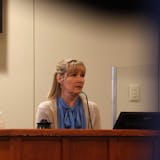At Metcalf Junior High in Burnsville, students are using iPads to write, edit and record video book reviews for their peers in hopes of enticing more of them to crack a book.
At Sky Oaks Elementary, teachers are using iPad apps to perform almost real-time assessments of student performance on math assignments.
At Harriet Bishop, another Burnsville elementary school, the iPads are being used for individual learning time when kids read at their own level called the "Power Half Hour."
It's all part of the Burnsville school district's (belated) push into using new technology to improve education.
Unlike many neighboring school districts — such as Farmington and Lakeville, which have jumped head-first into the iPad pool — Burnsville is intentionally taking things much more slowly.
Instead of buying millions of dollars in iPads and accessories, Burnsville has started with a few dozen teachers and classrooms, testing out the new equipment as part of a districtwide research project.
The results of the Improving Student Achievement Through Technology program will be on display Thursday afternoon at the Diamondhead Education Center in Burnsville.
About 70 teachers will demonstrate their projects and the progress students have made this year through the use of technology.



